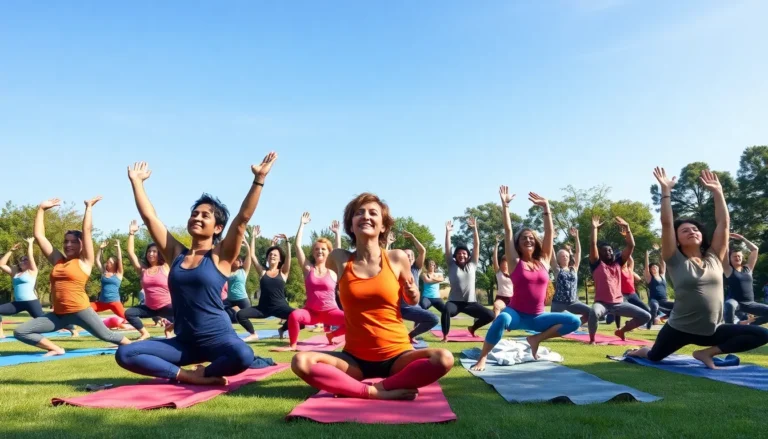Table of Contents
ToggleStarting a fitness journey can feel like stepping into a gym full of superheroes while you’re still figuring out how to tie your shoelaces. But don’t worry! Everyone’s got to start somewhere, and with the right beginner fitness plan, even the most reluctant couch potato can transform into a workout warrior.
Overview of a Beginner Fitness Plan
A structured approach helps newcomers embark on their fitness journeys. A beginner fitness plan outlines essential steps to promote consistent engagement and healthy habits.
Importance of Starting with a Plan
Establishing a fitness plan creates clarity and direction. It encourages individuals to set realistic targets while maintaining motivation. With a defined framework, beginners can measure progress effectively. Each component of the plan—workouts, nutrition, and rest—contributes to overall well-being. Beginners experience fewer setbacks when they follow a strategic routine tailored to their needs.
Common Goals for Beginners
Many individuals aim to achieve specific fitness goals. Weight loss often ranks as a primary objective for newcomers. Building strength and enhancing endurance also feature prominently in beginner aspirations. Others focus on improving flexibility or overall health through consistent activity. Social engagement, like joining fitness classes, serves as an additional motivation for many. Identifying personal goals paves the way toward sticking with a fitness regime.
Key Components of a Beginner Fitness Plan

A well-structured beginner fitness plan includes essential components that promote overall well-being. Focusing on these elements ensures a balanced approach to fitness.
Cardiovascular Exercises
Cardiovascular exercises elevate heart rate and enhance endurance. Activities like walking, jogging, cycling, and swimming offer varied options. Beginners can start with 20 to 30 minutes of moderate-intensity cardio three to five times per week. Gradually increasing duration and intensity boosts cardiovascular health. Accessing local parks, gyms, or fitness classes motivates individuals to stay on track. These exercises not only burn calories but also strengthen the heart and lungs.
Strength Training Basics
Strength training focuses on building muscle and improving metabolism. Bodyweight exercises, free weights, or resistance bands cater to new individuals. Initiating with two to three sessions per week fosters muscle growth and stability. Compound movements like squats, push-ups, and lunges engage multiple muscle groups efficiently. Beginners should aim for 1 to 3 sets of 8 to 12 repetitions for each exercise. Recognizing the value of proper form prevents injuries and maximizes results.
Flexibility and Mobility
Flexibility and mobility enhance overall performance and reduce injury risk. Incorporating stretching exercises helps improve range of motion. Practicing activities like yoga or dedicated stretching routines promotes relaxation and muscle recovery. Focusing on major muscle groups during stretching sessions is essential. For optimal results, individuals should stretch for at least 10 to 15 minutes after workouts. Prioritizing flexibility at least two to three times per week improves athletic performance and daily movement.
Creating Your Own Beginner Fitness Plan
Crafting a personalized fitness plan starts with understanding one’s own fitness level and goals. This tailored approach enables individuals to make informed decisions throughout their journey.
Assessing Your Current Fitness Level
Evaluating fitness levels serves as a foundational step in developing a beginner fitness plan. It involves considering factors such as previous exercise experience, current activity status, and any medical conditions. Simple assessments like a timed walk or a strength test using bodyweight exercises can provide clear insights. Knowing endurance levels informs the selection of appropriate workouts. For example, someone new to fitness might start with walking for 10 minutes, gradually increasing duration as strength builds. This creates a benchmark for progress and allows individuals to track improvements over time.
Setting Realistic Goals
Establishing achievable fitness goals transforms aspirations into actionable steps. SMART goals—specific, measurable, attainable, relevant, and time-bound—help individuals maintain focus and motivation. Rather than vague objectives, concrete goals, like losing five pounds in two months or completing a 5K run, offer clarity. Incorporating short-term targets aids in recognizing incremental progress. Regularly reviewing and adjusting these goals ensures they stay aligned with personal growth and circumstances. Keeping goals realistic enhances the likelihood of commitment and success throughout the fitness journey.
Choosing the Right Exercises
Selecting suitable exercises forms a crucial aspect of a beginner fitness plan. It’s essential to choose a mix of cardiovascular training, strength building, and flexibility workouts. For instance, brisk walking, cycling, and swimming enhance cardiovascular health effectively. Weight training with bodyweights or resistance bands supports muscle development. Including yoga or stretching routines promotes flexibility and reduces injury risks. Balancing these exercise types creates a comprehensive plan that engages different muscle groups. Adjusting intensity and variety keeps routines enjoyable and sustainable, fostering lifelong fitness habits.
Tips for Staying Motivated
Staying motivated in a fitness journey poses challenges and opportunities. Implementing effective strategies helps reinforce commitment and enjoyment.
Tracking Progress
Monitoring progress provides valuable insights into fitness journeys. Utilizing apps or journals makes it easier to note achievements, such as increased endurance or strength gains. Regularly reviewing this data keeps individuals accountable. Setting milestones, like completing a certain number of workouts each month, fuels motivation. Celebrate each success, no matter how small, to foster a sense of accomplishment.
Finding a Workout Buddy
Working out with a partner can enhance motivation significantly. Engaging with a workout buddy provides support and encouragement. They can also make exercise sessions more enjoyable. Sharing fitness goals creates a sense of accountability, encouraging each person to stay on track. Coordinating schedules promotes consistency in workouts, making it easier to commit.
Mixing Up Your Routine
Variety plays a crucial role in maintaining motivation. Altering workouts prevents boredom and stimulates progress. Incorporating different activities, such as cycling, swimming, or dance classes, keeps things fresh. Experimenting with new exercises helps discover strengths and preferences. Scheduling regular changes in routines sustains interest and challenges the body, leading to lasting results.
Embarking on a fitness journey can be daunting but with the right beginner fitness plan it becomes a manageable and rewarding experience. By focusing on structured workouts nutrition and rest individuals can build a solid foundation for their health. Setting realistic goals and tracking progress keeps motivation high and encourages commitment.
Incorporating a variety of exercises not only enhances physical fitness but also makes the process enjoyable. Engaging with others through classes or workout partners adds a social element that can further boost motivation. As one navigates this journey every small step taken is a move toward a healthier lifestyle. With dedication and consistency anyone can achieve their fitness aspirations and transform their lives.







